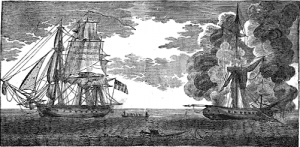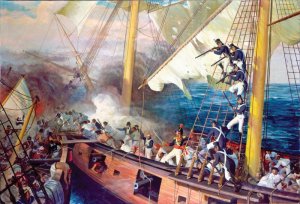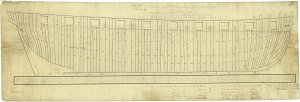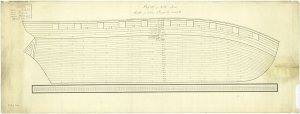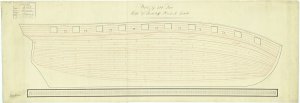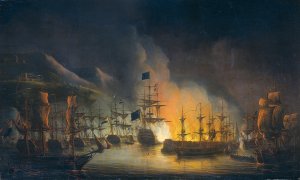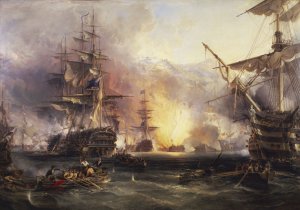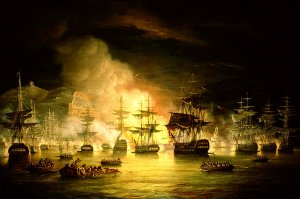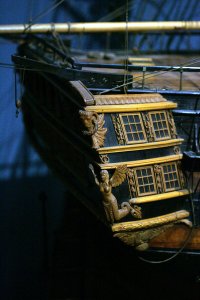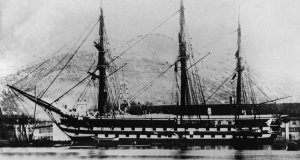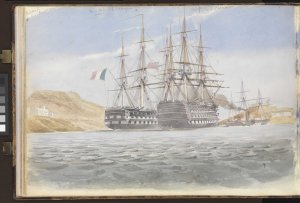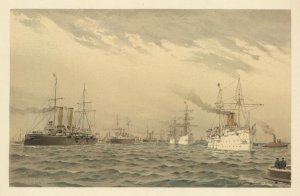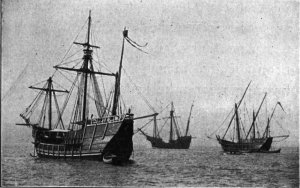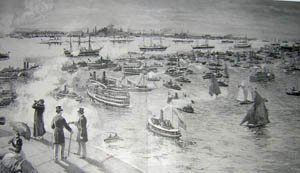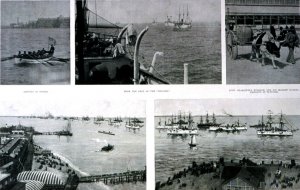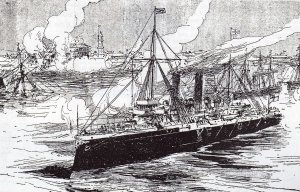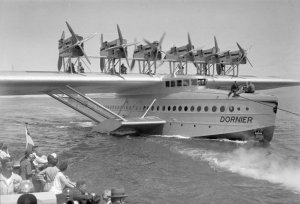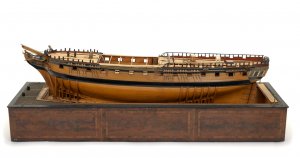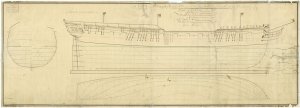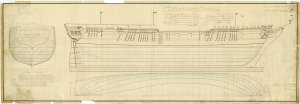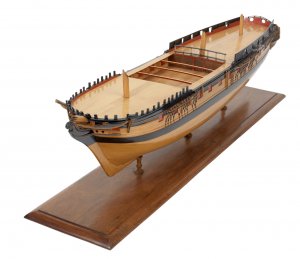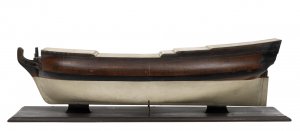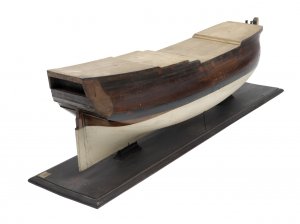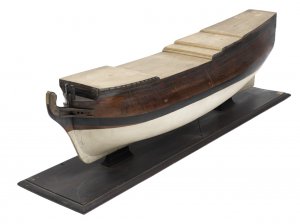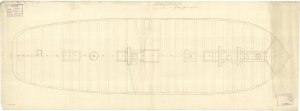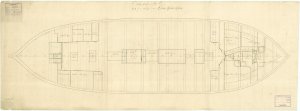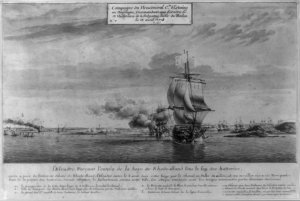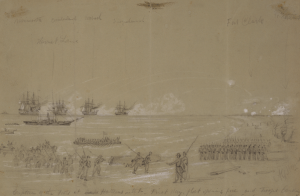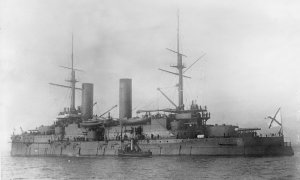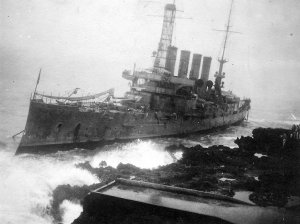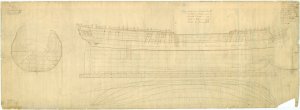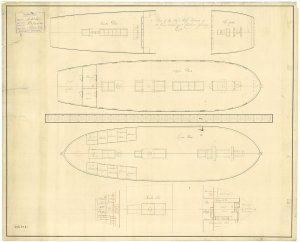Today in Naval History - Naval / Maritime Events in History
Events on 26 August
1652 - Battle of Plymouth
The Battle of Plymouth was a naval battle in the First Anglo-Dutch War. It took place on 16 August 1652 (26 August 1652 (Gregorian calendar))[a] and was a short battle, but had the unexpected outcome of a Dutch victory over England. General-at-Sea George Ayscue of the Commonwealth of Englandattacked an outward bound convoy of the Dutch Republic commanded by Vice-Commodore Michiel de Ruyter. The two commanders had been personal friends before the war. The Dutch were able to force Ayscue to break off the engagement, and the Dutch convoy sailed safely to the Atlantic while Ayscue sailed to Plymouth for repairs.

Michiel de Ruyter painted by Ferdinand Bol in 1667
Loss of prestige for the English and the beginning of fame for De Ruyter
The English ships had expected to easily defeat the Dutch in a set battle because of their superiority in armament and numbers. While the failure came as an unpleasant surprise to the English, the Dutch populace rejoiced in the tactical draw, hailing De Ruyter, who had not been well known among the larger public, as a naval hero. The English accused some merchantmen captains of cowardice. Ayscue was blamed for poor leadership and organisation: his attempt to present the encounter as a victory failed to convince. He lost command after this battle, though probably for political reasons: he had known royalist sympathies. Less important was his emphasis on capturing prizes while avoiding battle; in the first year of the war this was a very common attitude, the English mainly seeing the conflict as one large privateering campaign, allowing them to gain riches at the expense of the Dutch; only with the Battle of the Gabbard would they really try to establish naval dominion.
This victory was very important to the naval career of De Ruyter: it was the first time he commanded an independent force as a fleet commander. Before, he only had had subcommand of a flotilla aiding Portugal in 1641. As a result of the battle he acquired the nickname The Sea Lion. Before he could return home, De Ruyter was first involved in the Battle of the Kentish Knock but arriving in Middelburg he was received by the States of Zealand and rewarded with a golden honorary chain of a hundred Flemish pounds for both battles because he in the first had shown "masculine courage" and in the second "courageous prudence" — having convinced Witte de With to a timely retreat.
http://en.wikipedia.org/wiki/Battle_of_Plymouth
1711 - HMS Greyhound (1702 - 40) wrecked in Tynemouth.
https://en.wikipedia.org/wiki/HMS_Greyhound_(1702)
1767 - Launch of HMS Marlboro (1767 - 74)
HMS Marlborough was a 74-gun third rate ship of the line of the Royal Navy, launched on 26 August 1767 at Deptford. She was one of the Ramilliesclass built to update the Navy and replace ships lost following the Seven Years' War. She was first commissioned in 1771 under Captain Richard Bickerton as a guard ship for the Medway and saw active service in the American Revolutionary War and on the Glorious First of June. At the battle of the First of June Marlborough suffered heavy damage apparently as a result of her white ensign being mistaken for the French ensign.
On the evening of 3 November 1800 Marlborough was at sea in a storm off Brittany's Belle Île when strong winds drove her onto a partially submerged ledge of rocks. A substantial breach was opened in her hull and she began to batter against the rocks with each incoming wave. Her commander, Captain Thomas Sotheby, ordered the ship's guns and stores to be thrown overboard to lighten her, but she remained stuck fast.
The storm abated by the following morning, but the ship had settled on the rocks and was awash to her orlop deck as waves flowed in through the hull. A distress signal was raised and answered by HMS Captain which drew close to Marlborough and succeeded in taking off all 600 of her crew. No attempt was made to salvage the ship itself.
http://en.wikipedia.org/wiki/HMS_Marlborough_(1767)
1768 – Captain James Cook sets sail from England on board HMS Endeavour.
https://en.wikipedia.org/wiki/First_voyage_of_James_Cook
https://en.wikipedia.org/wiki/HMS_Endeavour
1791 – John Fitch is granted a United States patent for the steamboat.
Fitch was granted a U.S. patent on August 26, 1791, after a battle with James Rumsey, who had also invented a steam-powered boat. The newly created federal Patent Commission did not award the broad monopoly patent that Fitch had asked for, but rather a patent of the modern kind, for the new design of Fitch's steamboat. It also awarded steam-engine-related patents dated that same day to Rumsey, Nathan Read, and John Stevens. The loss of a monopoly due to these same-day patent awards led many of Fitch's investors to leave his company. While his boats were mechanically successful, Fitch no longer had the financial resources to carry on.


Model of the "Perseverance (steam locomotive)," Deutsches Technikmuseum Berlin, Germany.
https://en.wikipedia.org/wiki/John_Fitch_(inventor)
1799 - The Artois class frigate HMS Tamar (1796 - 38), Cptn. Thomas Western, captured the French corvette Republicaine (32), Capt. Le Bozee.
https://en.wikipedia.org/wiki/Artois-class_frigate
1804 - HMS Immortalite (42), Cptn. Edward William Campbell Owen, HMS Harpy (18), sloop, Edmund Heywood, HMS Adder (12), gunbrig, Lt. George Wood, and HMS Constitution, cutter, James Samuel Denis, engaged more than 90 brigs and luggers off Boulogne. HMS Constitution was sunk by a shell off Cap Gris Nez .
1808 - HMS Implacable (74), Cptn. Thomas Byam Martin, and HMS Centaur (74), Cptn. W. H. Webley, captured Russian Vsevelod (74), Cptn. Roodneff, which was subsequently set on fire as it had run too firmly aground.
The Russian ship Vsevolod (1796) (also Vsewolod; Russian: Всеволод) was a 74-gun ship of the line launched in 1796. She served in the North Sea and the Baltic until the British 74-gun third rates Implacable and Centaur destroyed her in 1808 during the Anglo-Russian War (1807-1812).
On 24 August Vsevolod, under Captain Rudno (or Rudnew or Roodneff) exchanged fire with Implacable, with the Russian suffering heavy casualties before running aground. During this exchange three nearby Russian ships failed to render assistance. Vsevolod hauled down her colors, but Hood recalled Implacable because the Russian fleet was approaching. During the fight Implacable lost six men killed and twenty-six wounded, including two who did not recover and three who had limbs amputated.; Vsevolod lost some 48 dead and 80 wounded.
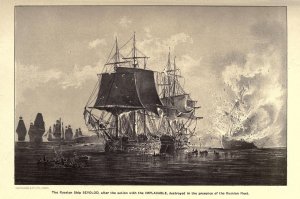
Vsevolod burning, after the action with the Implacableand Centaur, destroyed in the presence of the Russian Fleet near Rogerwick bay on 26 August 1808.
The Russian frigate Poluks then towed Vsevolod towards Rager Vik (Ragerswik or Rogerswick or Russian: Baltiyskiy) where the Russian fleet was sheltering. However, Vsevolod grounded some six miles from the port.
On 25 August Centaur came up and was able to drive off the boats that were attempting to get the disabled ship into harbor. Seamen from Centaur were able to lash her mizzen to the Russian bowsprit before Centaur opened fire. Both vessels grounded, and both sides attempted to board the other vessel. However, Implacable came up and fired into Vsevolod for about 10 minutes, forcing the Russian to strike again. Implacable hauled Centaur off. The battle had cost Centaur three killed and 27 wounded. Vsevolod, which had received about 100 men as reinforcements after her initial battle with Implacable, lost another 124 men killed and wounded in the battle with Centaur; 56 Russians swam ashore and so escaped being taken prisoner.
Their prize was so firmly aground that Sir Samuel Hood, in Centaur, ordered Vsevolod burnt. On 26 August the British removed their prisoners, including the wounded, and then set fire to Vsevolod, which blew up some hours later. The cutter Baltic would later land the prisone
https://en.wikipedia.org/wiki/HMS_Implacable_(1805)
https://en.wikipedia.org/wiki/Russian_ship_Vsevolod_(1796)
1810 - French frigate squadron of Bellone, Minerve, Victor and captured Indiaman Ceylon, defeated a British squadron at Vieux Grand Port, Mauritius. HMS Nereide (38), Cptn. Nesbit J. Willoughby, and HMS Iphegenia (36), Cptn. Henry Lambert, struck. HMS Sirius (36), Cptn. Samuel Pym, and HMS Magicienne (32), Cptn. Lucius Curtis, were both burnt to prevent them falling into enemy hands after grounding.
1859 - The Novara-Expedition, he first large-scale scientific, around-the-world mission of the Austrian Imperial navy is returning to Triest
Authorized by Archduke Maximillian, the journey lasted 2 years 3 months, from 30 April 1857 until 30 August 1859.

The expedition was accomplished by the frigate Novara, under the command of Kommodore Bernhard von Wüllerstorf-Urbair, with 345 officers and crew, plus seven (7) scientists aboard. Preparation for the research journey was made by the "Imperial Academy of Sciences in Vienna" and by specialized scholars under direction of the geologist Ferdinand von Hochstetter and the zoologist Georg von Frauenfeld. The first coca plant (cocaine) investigations, in particular on St. Paul Island, the Nicobar Islands, and on New Zealand (first geological mapping by Hochstetter), created the bases for future geological research. The oceanographic research, in particular in the South Pacific, revolutionized oceanography and hydrography.
The collections of botanical, zoological (26,000 preparations), and cultural material brought back enriched the Austrian museums (especially the natural-history museum). They were also studied by Johann Natterer, a scientist who collected Vienna museum specimens during 18 years in South America. The geomagnetic observations made throughout the whole expedition significantly increased the scientific knowledge in this field. Finally, the expedition's introduction of coca plant leaves made it possible to isolate cocaine in its pure form for the first time in 1860.
https://de.wikipedia.org/wiki/Novara-Expedition
https://en.wikipedia.org/wiki/SMS_Novara_(1850)
1865 - American Civil War ends with Naval strength over 58,500 men and 600 ships
1922 - japanese light cruiser Niitaka sunk in storm near westcoast of Kamtschatka. The complete crew of 400 lost
On 26 August 1922, Niitaka anchored near the mouth of a river in what is now part of the Ust-Bolsheretsky District on the southern coast of the Kamchatka Peninsula, while a party of 15 led by Lieutenant Shigetada Gunji went ashore. Sudden typhoon-force winds drove the vessel onto rocks, where it overturned, killing all 284 people aboard at 51°30′N 156°29′ECoordinates: 51°30′N 156°29′E. The only survivors were the members of the shore party. A Russian source states that the captain survived the accident, only to commit seppuku afterwards.
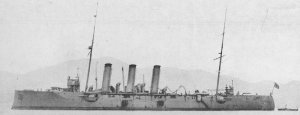
A salvage team sent in 1923 determined the wreck to be unsalvageable, and destroyed the remains with explosives. A concrete obelisk was also erected with a portion of the ship’s mast on a hill slightly north of the wreck site. Niitaka was formally written off the navy list on 1 April 1924.
https://en.wikipedia.org/wiki/Japanese_cruiser_Niitaka
1949 - While operating in stormy seas off northern Norway, USS Cochino (SS 345) suffers a series of serious battery explosions that result in her loss. Though Cochino's crew is successfully rescued by USS Tusk (SS 426), the submarine loses seven of her own men during this difficult effort.

USS Cochino (SS-345), a Balao-class submarine, was the only ship of the United States Navy to be named for the cochino, a triggerfish found in the Atlantic. Her keel was laid down by Electric Boat Company of Groton, Connecticut. She was launched on April 20, 1945 sponsored by Mrs. M.E. Serat, and commissioned on August 25, 1945 with Commander W.A. Stevenson in command.
Cochino joined the U.S Atlantic Fleet, cruising East Coast and Caribbean Sea waters from her home port of Key West, Florida. On July 18, 1949, she put to sea for a cruise to Britain, and arctic operations. Her group ran through a violent polar gale off Norway, and the joltings received by Cochino played their part on August 25 in causing an electrical fire and battery explosion, followed by the generation of both hydrogen and chlorine gases.
Defying the most unfavorable possible weather conditions, Commander (later Rear Admiral) Rafael Celestino Benítez (1917–1999), commanding officer of Cochino, and his men fought for 14 hours to save the submarine, displaying seamanship and courage. But a second battery explosion on August 26 made "Abandon Ship" the only possible order, and Cochino sank. Tusk's crew rescued all of Cochino's men except for Robert Wellington Philo, a civilian engineer. Six sailors from Tusk were lost during the rescue.
Cochino is one of four United States Navy submarines to be lost since the end of World War II. The others are USS Stickleback, USS Thresher and USS Scorpion.
https://en.wikipedia.org/wiki/USS_Cochino_(SS-345)
Events on 26 August
1652 - Battle of Plymouth
The Battle of Plymouth was a naval battle in the First Anglo-Dutch War. It took place on 16 August 1652 (26 August 1652 (Gregorian calendar))[a] and was a short battle, but had the unexpected outcome of a Dutch victory over England. General-at-Sea George Ayscue of the Commonwealth of Englandattacked an outward bound convoy of the Dutch Republic commanded by Vice-Commodore Michiel de Ruyter. The two commanders had been personal friends before the war. The Dutch were able to force Ayscue to break off the engagement, and the Dutch convoy sailed safely to the Atlantic while Ayscue sailed to Plymouth for repairs.

Michiel de Ruyter painted by Ferdinand Bol in 1667
Loss of prestige for the English and the beginning of fame for De Ruyter
The English ships had expected to easily defeat the Dutch in a set battle because of their superiority in armament and numbers. While the failure came as an unpleasant surprise to the English, the Dutch populace rejoiced in the tactical draw, hailing De Ruyter, who had not been well known among the larger public, as a naval hero. The English accused some merchantmen captains of cowardice. Ayscue was blamed for poor leadership and organisation: his attempt to present the encounter as a victory failed to convince. He lost command after this battle, though probably for political reasons: he had known royalist sympathies. Less important was his emphasis on capturing prizes while avoiding battle; in the first year of the war this was a very common attitude, the English mainly seeing the conflict as one large privateering campaign, allowing them to gain riches at the expense of the Dutch; only with the Battle of the Gabbard would they really try to establish naval dominion.
This victory was very important to the naval career of De Ruyter: it was the first time he commanded an independent force as a fleet commander. Before, he only had had subcommand of a flotilla aiding Portugal in 1641. As a result of the battle he acquired the nickname The Sea Lion. Before he could return home, De Ruyter was first involved in the Battle of the Kentish Knock but arriving in Middelburg he was received by the States of Zealand and rewarded with a golden honorary chain of a hundred Flemish pounds for both battles because he in the first had shown "masculine courage" and in the second "courageous prudence" — having convinced Witte de With to a timely retreat.
http://en.wikipedia.org/wiki/Battle_of_Plymouth
1711 - HMS Greyhound (1702 - 40) wrecked in Tynemouth.
https://en.wikipedia.org/wiki/HMS_Greyhound_(1702)
1767 - Launch of HMS Marlboro (1767 - 74)
HMS Marlborough was a 74-gun third rate ship of the line of the Royal Navy, launched on 26 August 1767 at Deptford. She was one of the Ramilliesclass built to update the Navy and replace ships lost following the Seven Years' War. She was first commissioned in 1771 under Captain Richard Bickerton as a guard ship for the Medway and saw active service in the American Revolutionary War and on the Glorious First of June. At the battle of the First of June Marlborough suffered heavy damage apparently as a result of her white ensign being mistaken for the French ensign.
On the evening of 3 November 1800 Marlborough was at sea in a storm off Brittany's Belle Île when strong winds drove her onto a partially submerged ledge of rocks. A substantial breach was opened in her hull and she began to batter against the rocks with each incoming wave. Her commander, Captain Thomas Sotheby, ordered the ship's guns and stores to be thrown overboard to lighten her, but she remained stuck fast.
The storm abated by the following morning, but the ship had settled on the rocks and was awash to her orlop deck as waves flowed in through the hull. A distress signal was raised and answered by HMS Captain which drew close to Marlborough and succeeded in taking off all 600 of her crew. No attempt was made to salvage the ship itself.
http://en.wikipedia.org/wiki/HMS_Marlborough_(1767)
1768 – Captain James Cook sets sail from England on board HMS Endeavour.
https://en.wikipedia.org/wiki/First_voyage_of_James_Cook
https://en.wikipedia.org/wiki/HMS_Endeavour
1791 – John Fitch is granted a United States patent for the steamboat.
Fitch was granted a U.S. patent on August 26, 1791, after a battle with James Rumsey, who had also invented a steam-powered boat. The newly created federal Patent Commission did not award the broad monopoly patent that Fitch had asked for, but rather a patent of the modern kind, for the new design of Fitch's steamboat. It also awarded steam-engine-related patents dated that same day to Rumsey, Nathan Read, and John Stevens. The loss of a monopoly due to these same-day patent awards led many of Fitch's investors to leave his company. While his boats were mechanically successful, Fitch no longer had the financial resources to carry on.


Model of the "Perseverance (steam locomotive)," Deutsches Technikmuseum Berlin, Germany.
https://en.wikipedia.org/wiki/John_Fitch_(inventor)
1799 - The Artois class frigate HMS Tamar (1796 - 38), Cptn. Thomas Western, captured the French corvette Republicaine (32), Capt. Le Bozee.
https://en.wikipedia.org/wiki/Artois-class_frigate
1804 - HMS Immortalite (42), Cptn. Edward William Campbell Owen, HMS Harpy (18), sloop, Edmund Heywood, HMS Adder (12), gunbrig, Lt. George Wood, and HMS Constitution, cutter, James Samuel Denis, engaged more than 90 brigs and luggers off Boulogne. HMS Constitution was sunk by a shell off Cap Gris Nez .
1808 - HMS Implacable (74), Cptn. Thomas Byam Martin, and HMS Centaur (74), Cptn. W. H. Webley, captured Russian Vsevelod (74), Cptn. Roodneff, which was subsequently set on fire as it had run too firmly aground.
The Russian ship Vsevolod (1796) (also Vsewolod; Russian: Всеволод) was a 74-gun ship of the line launched in 1796. She served in the North Sea and the Baltic until the British 74-gun third rates Implacable and Centaur destroyed her in 1808 during the Anglo-Russian War (1807-1812).
On 24 August Vsevolod, under Captain Rudno (or Rudnew or Roodneff) exchanged fire with Implacable, with the Russian suffering heavy casualties before running aground. During this exchange three nearby Russian ships failed to render assistance. Vsevolod hauled down her colors, but Hood recalled Implacable because the Russian fleet was approaching. During the fight Implacable lost six men killed and twenty-six wounded, including two who did not recover and three who had limbs amputated.; Vsevolod lost some 48 dead and 80 wounded.

Vsevolod burning, after the action with the Implacableand Centaur, destroyed in the presence of the Russian Fleet near Rogerwick bay on 26 August 1808.
The Russian frigate Poluks then towed Vsevolod towards Rager Vik (Ragerswik or Rogerswick or Russian: Baltiyskiy) where the Russian fleet was sheltering. However, Vsevolod grounded some six miles from the port.
On 25 August Centaur came up and was able to drive off the boats that were attempting to get the disabled ship into harbor. Seamen from Centaur were able to lash her mizzen to the Russian bowsprit before Centaur opened fire. Both vessels grounded, and both sides attempted to board the other vessel. However, Implacable came up and fired into Vsevolod for about 10 minutes, forcing the Russian to strike again. Implacable hauled Centaur off. The battle had cost Centaur three killed and 27 wounded. Vsevolod, which had received about 100 men as reinforcements after her initial battle with Implacable, lost another 124 men killed and wounded in the battle with Centaur; 56 Russians swam ashore and so escaped being taken prisoner.
Their prize was so firmly aground that Sir Samuel Hood, in Centaur, ordered Vsevolod burnt. On 26 August the British removed their prisoners, including the wounded, and then set fire to Vsevolod, which blew up some hours later. The cutter Baltic would later land the prisone
https://en.wikipedia.org/wiki/HMS_Implacable_(1805)
https://en.wikipedia.org/wiki/Russian_ship_Vsevolod_(1796)
1810 - French frigate squadron of Bellone, Minerve, Victor and captured Indiaman Ceylon, defeated a British squadron at Vieux Grand Port, Mauritius. HMS Nereide (38), Cptn. Nesbit J. Willoughby, and HMS Iphegenia (36), Cptn. Henry Lambert, struck. HMS Sirius (36), Cptn. Samuel Pym, and HMS Magicienne (32), Cptn. Lucius Curtis, were both burnt to prevent them falling into enemy hands after grounding.
1859 - The Novara-Expedition, he first large-scale scientific, around-the-world mission of the Austrian Imperial navy is returning to Triest
Authorized by Archduke Maximillian, the journey lasted 2 years 3 months, from 30 April 1857 until 30 August 1859.

The expedition was accomplished by the frigate Novara, under the command of Kommodore Bernhard von Wüllerstorf-Urbair, with 345 officers and crew, plus seven (7) scientists aboard. Preparation for the research journey was made by the "Imperial Academy of Sciences in Vienna" and by specialized scholars under direction of the geologist Ferdinand von Hochstetter and the zoologist Georg von Frauenfeld. The first coca plant (cocaine) investigations, in particular on St. Paul Island, the Nicobar Islands, and on New Zealand (first geological mapping by Hochstetter), created the bases for future geological research. The oceanographic research, in particular in the South Pacific, revolutionized oceanography and hydrography.
The collections of botanical, zoological (26,000 preparations), and cultural material brought back enriched the Austrian museums (especially the natural-history museum). They were also studied by Johann Natterer, a scientist who collected Vienna museum specimens during 18 years in South America. The geomagnetic observations made throughout the whole expedition significantly increased the scientific knowledge in this field. Finally, the expedition's introduction of coca plant leaves made it possible to isolate cocaine in its pure form for the first time in 1860.
https://de.wikipedia.org/wiki/Novara-Expedition
https://en.wikipedia.org/wiki/SMS_Novara_(1850)
1865 - American Civil War ends with Naval strength over 58,500 men and 600 ships
1922 - japanese light cruiser Niitaka sunk in storm near westcoast of Kamtschatka. The complete crew of 400 lost
On 26 August 1922, Niitaka anchored near the mouth of a river in what is now part of the Ust-Bolsheretsky District on the southern coast of the Kamchatka Peninsula, while a party of 15 led by Lieutenant Shigetada Gunji went ashore. Sudden typhoon-force winds drove the vessel onto rocks, where it overturned, killing all 284 people aboard at 51°30′N 156°29′ECoordinates: 51°30′N 156°29′E. The only survivors were the members of the shore party. A Russian source states that the captain survived the accident, only to commit seppuku afterwards.

A salvage team sent in 1923 determined the wreck to be unsalvageable, and destroyed the remains with explosives. A concrete obelisk was also erected with a portion of the ship’s mast on a hill slightly north of the wreck site. Niitaka was formally written off the navy list on 1 April 1924.
https://en.wikipedia.org/wiki/Japanese_cruiser_Niitaka
1949 - While operating in stormy seas off northern Norway, USS Cochino (SS 345) suffers a series of serious battery explosions that result in her loss. Though Cochino's crew is successfully rescued by USS Tusk (SS 426), the submarine loses seven of her own men during this difficult effort.

USS Cochino (SS-345), a Balao-class submarine, was the only ship of the United States Navy to be named for the cochino, a triggerfish found in the Atlantic. Her keel was laid down by Electric Boat Company of Groton, Connecticut. She was launched on April 20, 1945 sponsored by Mrs. M.E. Serat, and commissioned on August 25, 1945 with Commander W.A. Stevenson in command.
Cochino joined the U.S Atlantic Fleet, cruising East Coast and Caribbean Sea waters from her home port of Key West, Florida. On July 18, 1949, she put to sea for a cruise to Britain, and arctic operations. Her group ran through a violent polar gale off Norway, and the joltings received by Cochino played their part on August 25 in causing an electrical fire and battery explosion, followed by the generation of both hydrogen and chlorine gases.
Defying the most unfavorable possible weather conditions, Commander (later Rear Admiral) Rafael Celestino Benítez (1917–1999), commanding officer of Cochino, and his men fought for 14 hours to save the submarine, displaying seamanship and courage. But a second battery explosion on August 26 made "Abandon Ship" the only possible order, and Cochino sank. Tusk's crew rescued all of Cochino's men except for Robert Wellington Philo, a civilian engineer. Six sailors from Tusk were lost during the rescue.
Cochino is one of four United States Navy submarines to be lost since the end of World War II. The others are USS Stickleback, USS Thresher and USS Scorpion.
https://en.wikipedia.org/wiki/USS_Cochino_(SS-345)





